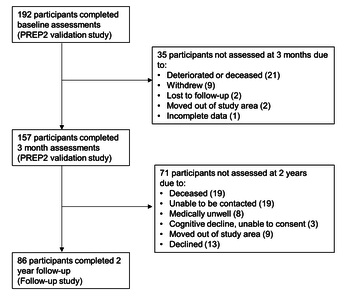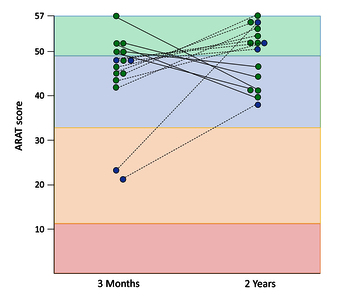Smith, Marie-Claire, Ackerley, Suzanne  ORCID: 0000-0002-7059-3329, Barber, P. Alan, Byblow, Winston D. and Stinear, Cathy M.
(2019)
PREP2 Algorithm Predictions Are Correct at 2 Years Poststroke for Most Patients.
Neurorehabilitation and Neural Repair, 33
(9).
pp. 635-642.
ISSN 1545-9683
ORCID: 0000-0002-7059-3329, Barber, P. Alan, Byblow, Winston D. and Stinear, Cathy M.
(2019)
PREP2 Algorithm Predictions Are Correct at 2 Years Poststroke for Most Patients.
Neurorehabilitation and Neural Repair, 33
(9).
pp. 635-642.
ISSN 1545-9683
Preview |
PDF (Author Accepted Manuscript)
- Accepted Version
Available under License Creative Commons Attribution Non-commercial No Derivatives. 200kB |
Preview |
Image (TIFF) (Author Accepted Manuscript - Figure 1)
- Accepted Version
Available under License Creative Commons Attribution Non-commercial No Derivatives. 9MB |
![Author Accepted Manuscript - Figure 2 [thumbnail of Author Accepted Manuscript - Figure 2]](https://clok.uclan.ac.uk/34859/4.hassmallThumbnailVersion/34859%20Smith%20Ackerley%202019_Figure%202%20v1.jpg)  Preview |
Image (JPEG) (Author Accepted Manuscript - Figure 2)
- Accepted Version
Available under License Creative Commons Attribution Non-commercial No Derivatives. 409kB |
![Author Accepted Manuscript - Figure 3 [thumbnail of Author Accepted Manuscript - Figure 3]](https://clok.uclan.ac.uk/34859/5.hassmallThumbnailVersion/34859%20Smith%20Ackerley%202019_Figure%203.jpg)  Preview |
Image (JPEG) (Author Accepted Manuscript - Figure 3)
- Accepted Version
Available under License Creative Commons Attribution Non-commercial No Derivatives. 501kB |
Official URL: https://doi.org/10.1177/1545968319860481
Abstract
Background. The PREP2 algorithm combines clinical and neurophysiological measures to predict upper-limb (UL) motor outcomes 3 months poststroke, using 4 prediction categories based on Action Research Arm Test (ARAT) scores. The algorithm was accurate at 3 months for 75% of participants in a previous validation study. Objective. This study aimed to evaluate whether PREP2 predictions made at baseline are correct 2 years poststroke. We also assessed whether patients’ UL performance remained stable, improved, or worsened between 3 months and 2 years after stroke. Methods. This is a follow-up study of 192 participants recruited and assessed in the original PREP2 validation study. Participants who completed assessments 3 months poststroke (n = 157) were invited to complete follow-up assessments at 2 years poststroke for the present study. UL outcomes were assessed with the ARAT, upper extremity Fugl-Meyer Scale, and Motor Activity Log. Results. A total of 86 participants completed 2-year follow-up assessments in this study. PREP2 predictions made at baseline were correct for 69/86 (80%) participants 2 years poststroke, and PREP2 UL outcome category was stable between 3 months and 2 years poststroke for 71/86 (83%). There was no difference in age, stroke severity, or comorbidities among patients whose category remained stable, improved, or deteriorated. Conclusions. PREP2 algorithm predictions made within days of stroke are correct at both 3 months and 2 years poststroke for most patients. Further investigation may be useful to identify which patients are likely to improve, remain stable, or deteriorate between 3 months and 2 years.
Repository Staff Only: item control page

 Tools
Tools Tools
Tools https://orcid.org/0000-0002-7059-3329
https://orcid.org/0000-0002-7059-3329
